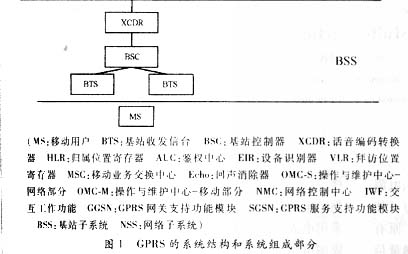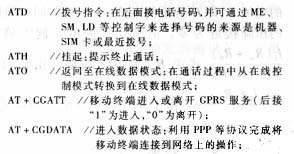GPRS and its application in wearable computers
Introduce the design of applying GPRS technology to wearable computers to make them more operable and flexible. The article focuses on GPRS technology, hardware and software implementation of GPRS module.
Keywords: GPRS; wearable computers; packet switching?
GPRS Technology and It's ApplicaTIon in the Wearable Computers
HUANG TIanshu, FU Hongye
(School of Electronic InformaTIon, Wuhan University, Wuhan 430072, China)
Abstract: In this passage, the use of GPRS in the wearable compu ter is introduced, this makes the computer has stronger operaTIon and facility. Especially it introduces the GPRS technology and the realiz ation of the hardware and software of the mode.
Keywords: GPRS; wearable computer; exchanging group
Keywords: GPRS; wearable computer; exchanging group
In recent years, wearable computers (wearable computers, WearComp) have quietly become a research hotspot. It makes human and computer into one, and improves human's overall interaction and computing ability. The introduction of wireless communication technologies represented by Bluetooth and GPRS technology into wearable computers can further develop its interactive approach towards mobility, accessibility, naturalness, and simplicity. ?
A wearable computer is a computer that can be controlled by voice and can be worn by people without using two hands. Compared with the traditional computer, it is a brand-new concept and adopts an open architecture. It not only miniaturizes the current computer and can be worn on humans, but also realizes the close integration of humans and machines, which effectively expands and extends the human brain and enhances human intelligence. At the same time, it also realizes a brand-new "people-oriented" human-computer interaction mode. The wearable computer came into being with the development of the ultra-miniaturization of computers and related components. It is also an inevitable product of people's pursuit of the concept of "computer should be people-oriented" and market demand. It expands the functions of the computer, opens up new application areas, and has a wide range of uses and huge market potential. ?
General Packet Radio Service (GPRS) is a new network superimposed on the existing Global System for Mobile Communications (GSM) network. Although GSM has many advantages, it does not support the simultaneous use of telephone services and digital services; it does not provide standard interfaces with fax machines, personal computers, and video teletext terminals; it does not support wireless packet data services. GPRS has improved in these aspects. It makes full use of the existing mobile communication network equipment, adds some hardware devices to the GSM network and upgrades the software to form a new network logical entity; it breaks through the GSM network and can only provide The thinking of circuit switching is based on packet switching technology and adopts IP data network protocol to provide a higher data rate (up to 170kbit / s) than the existing GSM network of 9.6kbit / s; it can provide a mobile environment for GSM users Under the high-speed data services, including sending and receiving e-mail, Internet browsing and other IP business functions.
In addition to the functions provided by the original GSM, GPRS can also provide many non-voice mobile services. For example, it can provide a complete wireless data communication solution for industrial "four remote"-remote sensing, telemetry, remote control, remote adjustment Wait.
2.1.1 GPRS system structure GPRS system structure and system composition are shown in Figure 1.
In addition to the functions provided by the original GSM, GPRS can also provide many non-voice mobile services. For example, it can provide a complete wireless data communication solution for industrial "four remote"-remote sensing, telemetry, remote control, remote adjustment Wait.
2.1.1 GPRS system structure GPRS system structure and system composition are shown in Figure 1.


2.1.2 Features of GPRS GPRS has opened the door to popular mobile data applications. With GPRS technology, users get the following benefits: ①charge only for the transmission data (actual usage) and not charge for the connection gap; ② maintain a permanent connection; ③ direct ISP access through IP is cheaper; ④ new applications can achieve real Insertion and operation plan; ⑤Users can instantly access a variety of services, such as: making voice calls while surfing the Internet; ⑥IP functions of mobile phones (Internet, telemetry, e-commerce, etc.).
Based on the mobility and flexibility of the wearable computer, being able to perform good wireless communication with the "outside world" has become its essential function. Therefore, we equipped WearComp with a wireless network card based on GPRS technology.
2.2 Design of GPRS Modem with USB interface
2.2.1 Hardware design The main components used in this Modem design include the single-chip microcomputer W77E58, the independent USB interface chip PDIUSBD12, and the GPRS module GM47 produced by Ericsson (Figure 2). ?
Based on the mobility and flexibility of the wearable computer, being able to perform good wireless communication with the "outside world" has become its essential function. Therefore, we equipped WearComp with a wireless network card based on GPRS technology.
2.2 Design of GPRS Modem with USB interface
2.2.1 Hardware design The main components used in this Modem design include the single-chip microcomputer W77E58, the independent USB interface chip PDIUSBD12, and the GPRS module GM47 produced by Ericsson (Figure 2). ?

The USB interface circuit is composed of PDIUSBD12 and W77E58: the 8-bit parallel data of PDIUSBD12 is connected to the P0 port of W77E58, and P2.6 is used as the selection line of PDIUSBD12 command or data. The data exchange between PDIUSBD12 and W77E58 adopts interrupt mode (INT0). The USB device is connected to the host computer or USBHub through a 4-wire cable. The four wires are: Vbus (bus power supply), GND (ground wire), D + and D- (data wire). The host detects the status of the device through the voltage changes on D + and D-.
The GPRS interface circuit is composed of the GM47 module and W77E58: as an application terminal module, GM47 is in contact with the MCU or PC controlling it through its own UART port. In the UART port pins, RD (serial data output) and TD (serial data input) are used as data ports to connect with RXD and TXD of W77E58 respectively, while CTS (transmit clear), RTS (transmit request), DTR ( The data terminal is ready), DCD (data valid detection) as the control port are connected to P1.0 ~ P1.3 of W77E58 respectively. In order to realize the function of GPRS, GM47 module also needs to complete the connection of SIM card, antenna, power supply and other parts. The module supports 5V or 3V SIM.
2.2.2 Software design USB part: W77E58 control software for PDIUSBD12 mainly completes USB protocol processing and data exchange and other application functions. In this design, the relatively high processing speed of W77E58 is used to handle the larger amount of data (such as compressed video, audio signals, etc.) sent by the wearable computer host.
GPRS part: The GM47GPRS software part provides an AT command set to control the operation of the system. By receiving the AT command sent from the UART, it interprets and executes the corresponding operation, so as to realize the corresponding function of the wireless modem. All Mod em commands start with a specific command prefix (AT) and end with a command end flag. The following are several commonly used AT commands:
 ?
?
AT + CGEREP // GPRS event report;
AT + CDREG // GPRS network registration status.
The GM47 module also provides many other instructions. These instructions lay the foundation for the powerful functions of the module and provide an excellent development platform for many application developers.
The GPRS interface circuit is composed of the GM47 module and W77E58: as an application terminal module, GM47 is in contact with the MCU or PC controlling it through its own UART port. In the UART port pins, RD (serial data output) and TD (serial data input) are used as data ports to connect with RXD and TXD of W77E58 respectively, while CTS (transmit clear), RTS (transmit request), DTR ( The data terminal is ready), DCD (data valid detection) as the control port are connected to P1.0 ~ P1.3 of W77E58 respectively. In order to realize the function of GPRS, GM47 module also needs to complete the connection of SIM card, antenna, power supply and other parts. The module supports 5V or 3V SIM.
2.2.2 Software design USB part: W77E58 control software for PDIUSBD12 mainly completes USB protocol processing and data exchange and other application functions. In this design, the relatively high processing speed of W77E58 is used to handle the larger amount of data (such as compressed video, audio signals, etc.) sent by the wearable computer host.
GPRS part: The GM47GPRS software part provides an AT command set to control the operation of the system. By receiving the AT command sent from the UART, it interprets and executes the corresponding operation, so as to realize the corresponding function of the wireless modem. All Mod em commands start with a specific command prefix (AT) and end with a command end flag. The following are several commonly used AT commands:
 ?
? AT + CGEREP // GPRS event report;
AT + CDREG // GPRS network registration status.
The GM47 module also provides many other instructions. These instructions lay the foundation for the powerful functions of the module and provide an excellent development platform for many application developers.
As a new generation of computer systems and digital electronic products, wearable computers will revolutionize the relationship between people and computers and the way computers are used. This article introduces the design of introducing GPRS technology into WearComp. Although the system is still in the laboratory research stage, it provides a good technical framework for the future development of wearable computers. ?
Nantong Boxin Electronic Technology Co., Ltd. , https://www.bosencontrols.com